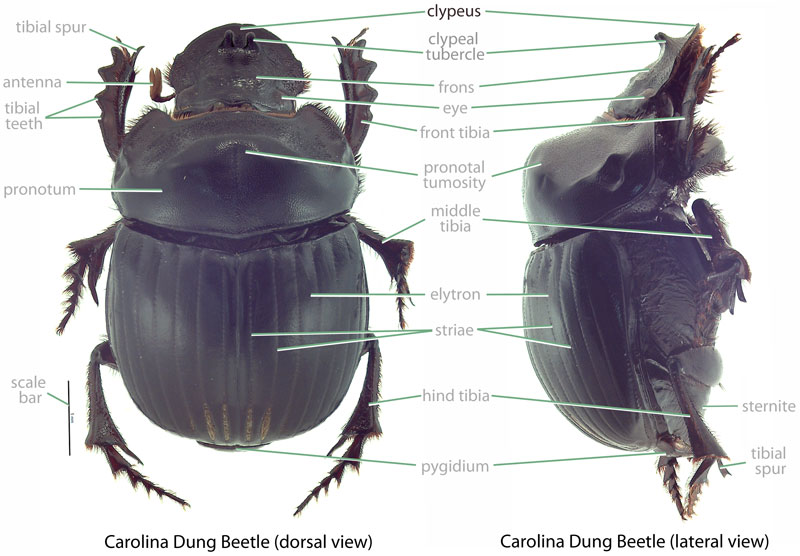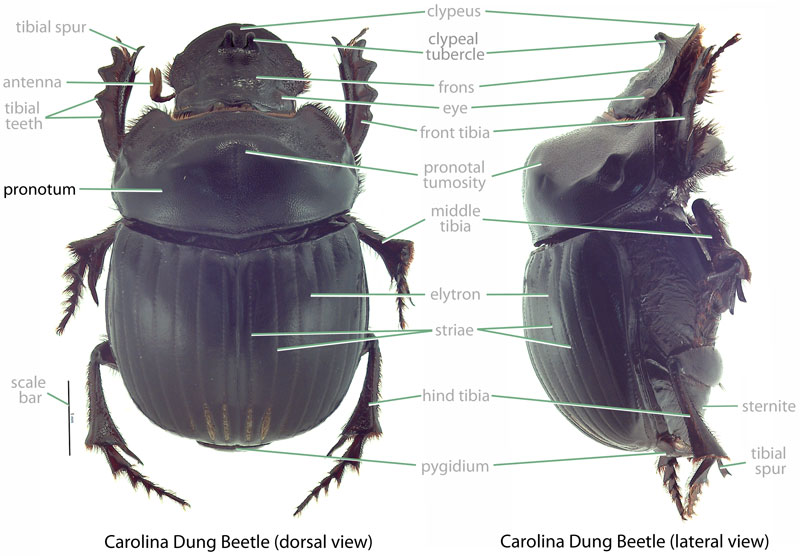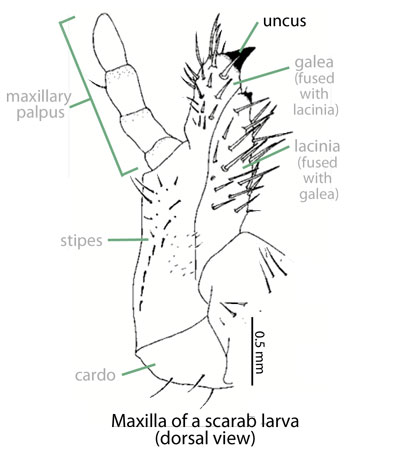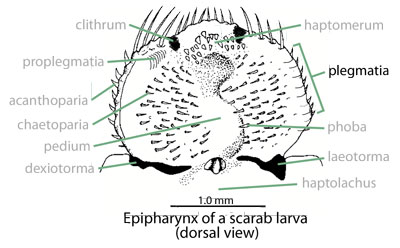Potential Invader
taro beetles
Family: Scarabaeidae Subfamily: Dynastinae Genus: Papuana
none available
Papuana is a genus of medium-sized scarab beetles that are armed with horns or tubercles. All species are shiny black and have an elongated, oval body shape. Total body length ranges between 15.0–30.0 mm (0.59–1.18 in). The apexapex:
point or edge furthest from the body
of the clypeusclypeus:
part of the head anterior to the frons; the most anterior portion in dorsal view
 is broad and never has 2 teeth close together. Both males and females have either tubercles or horns on the clypeusclypeus:
is broad and never has 2 teeth close together. Both males and females have either tubercles or horns on the clypeusclypeus:
part of the head anterior to the frons; the most anterior portion in dorsal view
 . Males of many species also have horns or tubercles on the pronotumpronotum:
. Males of many species also have horns or tubercles on the pronotumpronotum:
the dorsal surface of the thorax
 . Horns, if present, are often reduced in females. The apexapex:
. Horns, if present, are often reduced in females. The apexapex:
point or edge furthest from the body
of the last sternitesternite:
the ventral part of a thoracic or abdominal segment
 is emarginateemarginate:
is emarginateemarginate:
notched or with a rounded section removed from the margin, often applied to the anterior margin of the clypeus
in male and rounded in the female.
Undescribed. For Dynastinae (Ritcher, 1966Ritcher, 1966:
Ritcher P. 1966. White grubs and their allies: a study of North American scarabaeoid larvae. Oregon State University Monographs, Studies in Entomology 4: 1-219.): Grub C-shaped, not hump-backed, cylindrical, whitish. Maxillamaxilla:
set of paired mouthparts located posterior to the mandibles
with galeagalea:
outer branch or lobe of the maxilla
 and lacinialacinia:
and lacinialacinia:
inner portion of the maxilla fused or nearly so. Lacinialacinia:
fused or nearly so. Lacinialacinia:
inner portion of the maxilla of maxillamaxilla:
of maxillamaxilla:
set of paired mouthparts located posterior to the mandibles
with 3 well-developed unciunci:
in scarab larvae, a hooked process on the distal margin of the maxilla
 . Maxillary stridulatory teeth truncatetruncate:
. Maxillary stridulatory teeth truncatetruncate:
appearing cut-off or suddenly shortened
. Legs 4-segmented. Anal opening transversetransverse:
extending horizontally across a surface
, straight or slightly curved. PlegmatiaPlegmatia:
in scarab larvae, a paired, lateral region with a somewhat sclerotized surface bordered by marginal spines with acanthoparia
 absent.
absent.
Indo-Pacific. All 19 described species (Aloalii et al., 1993Aloalii et al., 1993:
Aloalii I, Masamdu R, Theunis W, Thistleton B. 1993. Prospects for biological control of taro beetles, Papuana spp. (Coleoptera: Scarabaeidae), in the South Pacific [pp. 66-70]. In: Proceedings of the Sustainable Taro Culture for the Pacific Conference. University of Hawaii Publishing, Honolulu, Hawaii, USA. full text (accessed 2015)) are native to the Indo-Pacific area. Two species are known from the Philippines, one from the Moluccas, one from northern Australia, 14 from New Guinea, four from the Solomon Islands, and two from Vanuatu (Aloalii et al., 1993Aloalii et al., 1993:
Aloalii I, Masamdu R, Theunis W, Thistleton B. 1993. Prospects for biological control of taro beetles, Papuana spp. (Coleoptera: Scarabaeidae), in the South Pacific [pp. 66-70]. In: Proceedings of the Sustainable Taro Culture for the Pacific Conference. University of Hawaii Publishing, Honolulu, Hawaii, USA. full text (accessed 2015)).
While the best known plant host of the taro beetles (Papuana) is taro (Colocasia esculenta), other plants in the aroid family (Araceae) are also acceptable hosts including Alocasias spp., Cyrtosperma spp., and elephant ear (Xanthosoma sagittifolium). A number of non-aroids are also recorded as hosts: Angiopteris spp., banana (Musa spp.), cabbage (Brassica oleracea), cocoa (Theobroma cacao), coconut (Cocos nucifera), coffee (Coffea arabica), Crinium spp., Marattia spp., nut palm (Areca catechu), oil palm (Elaeis guineensis), peanuts (Arachis hypogea), pineapple (Ananas comosus), potato (Solanum tuberosum), purple yam (Dioscorea alata), sugarcane (Saccharum officinarum), sweet potato (Ipomoea batatas), tea (Camellia chinensis), and white yam (Dioscorea rotundata) (Aloalii et al., 1993Aloalii et al., 1993:
Aloalii I, Masamdu R, Theunis W, Thistleton B. 1993. Prospects for biological control of taro beetles, Papuana spp. (Coleoptera: Scarabaeidae), in the South Pacific [pp. 66-70]. In: Proceedings of the Sustainable Taro Culture for the Pacific Conference. University of Hawaii Publishing, Honolulu, Hawaii, USA. full text (accessed 2015); Lal et al., 2008Lal et al., 2008:
Lal S, Moxon J, Autar M, Milner R, Hunter D, Hazelman S, Atumurirava F, Kurika K, Vasuidreketi T. 2008. Taro beetle management in Papua New Guinea and Fiji. Final Project Report, ACIAR Project Number CS2/2000/044. full text (pdf automatic download) (accessed 2015)).
(Lal et al., 2008Lal et al., 2008:
Lal S, Moxon J, Autar M, Milner R, Hunter D, Hazelman S, Atumurirava F, Kurika K, Vasuidreketi T. 2008. Taro beetle management in Papua New Guinea and Fiji. Final Project Report, ACIAR Project Number CS2/2000/044. full text (pdf automatic download) (accessed 2015)): Eggs are laid in moist, organic, rich soils. For Papuana uninodis, larvaelarvae:
the immature form of an insect; in scarabs, also called grub or white grub; preceded by the egg stage, followed by the pupal stage
 emerge after an average of two weeks. The first instarinstar:
emerge after an average of two weeks. The first instarinstar:
in scarabs, one of the three larval growth phases (i.e., first instar, second instar, third instar), each ending with the larvae molting to the next phase
lasts an average of two weeks, the second instarinstar:
in scarabs, one of the three larval growth phases (i.e., first instar, second instar, third instar), each ending with the larvae molting to the next phase
4–5 weeks, and the final instarinstar:
in scarabs, one of the three larval growth phases (i.e., first instar, second instar, third instar), each ending with the larvae molting to the next phase
3–4 months. The entire pre-adult lifecycle lasts 17–28 weeks, varying with temperature and humidity. Adults can live as long as 22 months, during which time females lay about 140 eggs. Adults feed by boring into the corm of a variety of aroids. LarvaeLarvae:
the immature form of an insect; in scarabs, also called grub or white grub; preceded by the egg stage, followed by the pupal stage
 do not appear to cause direct plant damage. Instead, they feed on detritusdetritus:
do not appear to cause direct plant damage. Instead, they feed on detritusdetritus:
organic debris; particularly plant debris
and other organic soil debris.
Significant. Of the 19 species of taro beetles (Papuana), eight are major taro pests (Aloalii, 1993). In Fiji and Papua New Guinea, these beetles reduce yields by up to one third, and this has led to the abandonment of many taro farms (Lal et al., 2008Lal et al., 2008:
Lal S, Moxon J, Autar M, Milner R, Hunter D, Hazelman S, Atumurirava F, Kurika K, Vasuidreketi T. 2008. Taro beetle management in Papua New Guinea and Fiji. Final Project Report, ACIAR Project Number CS2/2000/044. full text (pdf automatic download) (accessed 2015)). Damage is caused by adults that bore into the taro corm (or root) and cause serious damage. Further, Papuana spp. have a history of invasiveinvasive:
a species that has recently arrived to a new location, usually via human activity, causing notable economic and/or ecological damage
establishment beyond their native range. Papuana hubneri, a species native to New Guinea, spread to Kiribati in 1934 and to Fiji by 1984 (Aloalii et al., 1993Aloalii et al., 1993:
Aloalii I, Masamdu R, Theunis W, Thistleton B. 1993. Prospects for biological control of taro beetles, Papuana spp. (Coleoptera: Scarabaeidae), in the South Pacific [pp. 66-70]. In: Proceedings of the Sustainable Taro Culture for the Pacific Conference. University of Hawaii Publishing, Honolulu, Hawaii, USA. full text (accessed 2015)).
Not established or recorded. There are no records of this genus from Hawaii.
Not established or recorded. There are no records of this genus from Guam.
While it is unclear how Papuana hubneri first arrived to Fiji and Kiribati, it is not difficult to imagine these scarabs hitchhiking on commercial shipments of taro or other host plants. Similar to other dynastine scarabs that are attracted to lights at night (Ratcliffe and Paulsen, 2008Ratcliffe and Paulsen, 2008:
Ratcliffe B and Paulsen P. 2008. The scarabaeoid beetles of Nebraska (Coleoptera: Scarabaeoidea). Bulletin of the University of Nebraska 22: 138-248.), it is likely that this beetle would be attracted to well-lit ports and airports. This would allow for hitchhiking on marine and air cargo. Because taro is cultivated throughout the Pacific, and beetles damage a broad range of economically important plants, Papuana spp. should be regarded as a significant potential biosecurity hazard in both Hawaii and Guam.
Scarabs most likely to be confused with this genus are members of the genera Ligyrus and Tomarus. While not recorded on Guam, the carrot beetle (Ligyrus gibbosus) has been found on Oahu, and other species such as the sugarcane beetle (Tomarus subtropicus) may arrive in the future. Papuana spp. may be distinguished from Tomarus by examination of the head (Papuana spp. usually with horns or tubercles on head versus L. gibbosus and T. subtropicus never with horns or tubercles) and clypealclypeal:
of, or referring to, the clypeus
apexapex:
point or edge furthest from the body
(Papuana spp. never with 2 close-set apical teeth versus clypeusclypeus:
part of the head anterior to the frons; the most anterior portion in dorsal view
 constricted with 2 close-set apical teeth in L. gibbosus and T. subtropicus).
constricted with 2 close-set apical teeth in L. gibbosus and T. subtropicus).
none known
In Hawaii, members of this genus represent new invasiveinvasive:
a species that has recently arrived to a new location, usually via human activity, causing notable economic and/or ecological damage
species. Prevent the spread of this species by reporting your observation at our iNaturalist project.